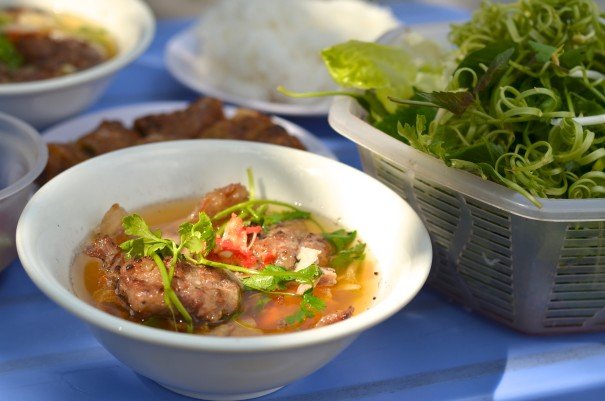
Nothing Says Success Like a Floor Covered in Trash

Nothing Says Success Like a Floor Covered in Trash
Bún chả in Ho Chi Minh City
Bún chả is a Hanoi specialty that’s become our family’s politically incorrect Sunday breakfast treat in Ho Chi Minh City. While the ill-will between Vietnam’s north and south isn’t as strong as it was in the past, there’s still distrust. Southerners regard Northerners as arrogant and proud, while Northerners think people from the South are uncouth and uncultured.
And then there’s the food.
Many Southern Vietnamese consider dishes from the country’s northern capital of Hanoi bland and uninspiring. My father-in-law certainly wasn’t happy with his breakfast when we took him to our local bún chả joint.
“Bún chả,” he kept muttering in distain as he ate, pausing only to add more pickled chilli to his bowl. Although he lives in the south now, he is from the former capital of Hue, on the banks of the Perfume River in Central Vietnam, where the food is famously spicy.
Like other interactive Vietnamese dishes, bún chả can be enhanced with fresh or pickled chilli and garlic. A range of condiments sit on the center of the table, so each diner can prepare their bowl to suit their individual preference for the level of heat and garlic.
A phần (portion) of bún chả consists of a plate of jiggly bún rice noodles, a basket of herbs, and the pièce de résistance, a bowl of barbecued pork patties and strips bobbing about in a warm, salty-sweet, fish sauce-y soup with carrot and papaya slices. We usually order a side of chả giò, pork and mushroom fried spring rolls.
The owner of our local joint, Ms. Bich (pronounced Bit), is from Hanoi, where the spring rolls are called nem. Because she’s selling to Southerners, she uses the local lingo, chả giò, for her delicious fried parcels. Her Hanoi accent, however, means she calls them “cha-zor” rather than “cha-yor,” as the Saigonese say.
Ms. Bich’s chả giò are delivered sizzling-hot, often with the glorious innards bursting out of the golden-brown skin. My favorite part of our weekend bún chả breakfast are the chả, the sweet, succulent pork patties. I usually order a chả-only portion, not wanting to bother with the fatty strips of barbecued pork.
A bún chả meal should be a balance of ying and yang, fried and fresh, sweet and savory. It’s considered a healthy dish because of the abundance of “vegetables” eaten with the noodles and pork: Asian basil, perilla, spirals of morning glory, lemon balm, bean sprouts, and pieces of bright green leaf lettuce.
Some bún chả places serve whole lettuce leaves, which can be used as wrappers to make a cigar-sized roll of pork, noodles and herbs. At our local bún chả place, however, the various components of the dish are assembled in a small rice bowl. A meal consists of several bowls, washed down with green tea.
Our place is breakfast-only. Arrive too late and Ms. Bich will waggle her hands and announce hết rồi (finished already) in her Hanoi accent that makes it sound like “het-zoi.”Arrive on time, and you’ll pass through a cloud of barbecue pork-scented smoke, billowing from the tiny brazier at the front. “Our” table is at the back of the open-air shed-like structure, at the tiny metal folding table that’s right under the fan.
Eating bún chả with our kids is a much more interactive experience than your average bún chả meal. Our six-year-old likes to play with Ms. Bich’s daughter, so keeping her at the table to eat can be difficult. Our two-year-old, meanwhile, enjoys chasing Ms. Bich’s cats, lurching into the small rooms that serve as the family’s private residence at the back of the restaurant.
When not cat-chasing, the baby likes to decant tea from the small metal teapot into the shot glasses on the table, a very messy exercise that often ends in tears (his) and tea-stained pants (mine). When he’s full, he’ll spit out a masticated mouthful of meatball and noodles. We kick this disgustingness under the table for the cats to eat later, when they’ve recovered from the indignity of being pursued.
At the end of a shift the discarded napkins and wayward pieces of food will be swept up. But when service is in full swing, only the cats and dogs notice the trash under the tables. In Vietnam, an eating place with a well-rubbished floor—and sleek pets—are a sign of a successful business.